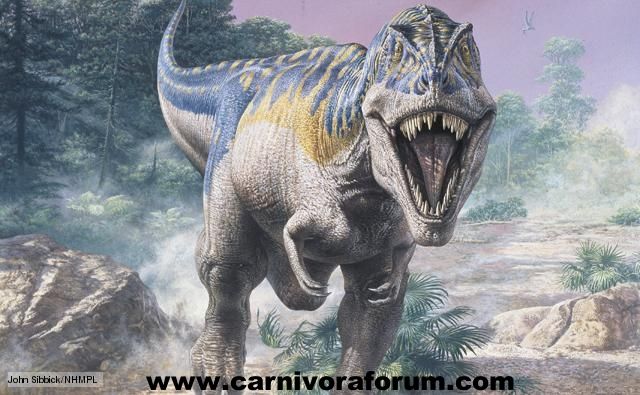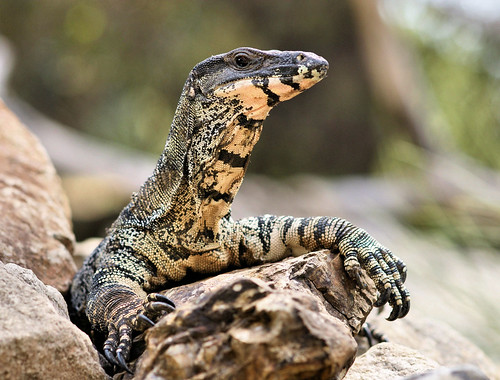Post by DinosaurMichael on May 4, 2012 17:52:45 GMT -5
Mandrill - Mandrillus sphinx
The mandrill (Mandrillus sphinx) is a primate of the Old World monkey (Cercopithecidae) family, closely related to the baboons and even more closely to the drill. It is found in southern Cameroon, Gabon, Equatorial Guinea, and Congo. Mandrills mostly live in tropical rainforests and forest-savanna mosaics. They live in groups called hordes. Mandrills have an omnivorous diet consisting mostly of fruits and insects. Their mating season takes place from June to October. Both the mandrill and the drill were once classified as baboons in genus Papio, but recent research has determined they should be separated into their own genus, Mandrillus. The mandrill is the world's largest species of monkey. Charles Darwin wrote in The Descent of Man that "no other member in the whole class of mammals is coloured in so extraordinary a manner as the adult male mandrills." The mandrill is classified as vulnerable by IUCN. The mandrill is perhaps the most colorful primate. It has an olive green or dark grey pelage with yellow and black bands and a white belly. Its hairless face has an elongated muzzle with distinctive characteristics such as a red stripe down the middle and protruding blue ridges on the sides. It also has red nostrils and lips, a yellow beard and white tuffs. The areas around the genitals and the anus are multi-colored, being colored red, pink, blue, scarlet, and purple. They also have pale pink ischial callosities. The coloration of the animal is more pronounced in dominant adult males. Both sexes have a patch of skin, surrounded by bristly hairs, on their chests that are used in olfactory communication. These, too, are more pronounced in dominant adult males. Males also have longer canines than females, with an average of 4.5 cm (1.8 in) and 1.0 cm, respectively. Males average 25–35 kg (55-77 lb); females are less than half that weight (11–14 kg, or 25-30 lb). Unusually large males can weigh 50 kg (110 lb). The average male is 81–90 cm (32–36 in) and the female is 56–66 cm (22–26 in), with the tail adding another 5–8 cm (2–3 in). They can survive up to 31 years in captivity. Females reach sexual maturity at about 3.5 years. The mandrill has one of the greatest sexual dimorphisms among the primates.

Velociraptor - Velociraptor mongoliensis
Velociraptor ( /vɨˈlɒsɨræptər/; meaning 'swift seizer') is a genus of dromaeosaurid theropod dinosaur that existed approximately 75 to 71 million years ago during the later part of the Cretaceous Period. Two species are currently recognized, although others have been assigned in the past. The type species is V. mongoliensis; fossils of this species have been discovered in Mongolia. A second species, V. osmolskae, was named in 2008 for skull material from Inner Mongolia, China. Smaller than other dromaeosaurids like Deinonychus and Achillobator, Velociraptor nevertheless shared many of the same anatomical features. It was a bipedal, feathered carnivore with a long, stiffened tail and an enlarged sickle-shaped claw on each hindfoot, which is thought to have been used to kill its prey. Velociraptor can be distinguished from other dromaeosaurids by its long and low skull, with an upturned snout. Velociraptor (commonly shortened to 'raptor') is one of the dinosaur genera most familiar to the general public due to its prominent role in the Jurassic Park motion picture series. In the films it was shown with anatomical inaccuracies, including being much larger than it was in reality and without feathers. It is also well known to paleontologists, with over a dozen described fossil skeletons—the most of any dromaeosaurid. One particularly famous specimen preserves a Velociraptor locked in combat with a Protoceratops. Velociraptor was a mid-sized dromaeosaurid, with adults measuring up to 2.07 m (6.8 ft) long, 0.5 m (1.6 ft) high at the hip, and weighing up to 15 kg (33 lb). The skull, which grew up to 25 cm (9.8 in) long, was uniquely up-curved, concave on the upper surface and convex on the lower. The jaws were lined with 26–28 widely spaced teeth on each side, each more strongly serrated on the back edge than the front—possibly an adaptation that improved its ability to catch and hold fast-moving prey. Velociraptor, like other dromaeosaurids, had a large manus ('hand') with three strongly curved claws, which were similar in construction and flexibility to the wing bones of modern birds. The second digit was the longest of the three digits present, while the first was shortest. The structure of the carpal (wrist) bones prevented pronation of the wrist and forced the 'hands' to be held with the palmar surface facing inwards (medially), not downwards. The first digit of the foot, as in other theropods, was a small dewclaw. However, whereas most theropods had feet with three digits contacting the ground, dromaeosaurids like Velociraptor walked on only their third and fourth digits. The second digit, for which Velociraptor is most famous, was highly modified and held retracted off of the ground. It bore a relatively large, sickle-shaped claw, typical of dromaeosaurid and troodontid dinosaurs. This enlarged claw, which could be over 6.5 cm (2.6 in) long around its outer edge, was most likely a predatory device used to tear into prey, possibly delivering a fatal blow.

The mandrill (Mandrillus sphinx) is a primate of the Old World monkey (Cercopithecidae) family, closely related to the baboons and even more closely to the drill. It is found in southern Cameroon, Gabon, Equatorial Guinea, and Congo. Mandrills mostly live in tropical rainforests and forest-savanna mosaics. They live in groups called hordes. Mandrills have an omnivorous diet consisting mostly of fruits and insects. Their mating season takes place from June to October. Both the mandrill and the drill were once classified as baboons in genus Papio, but recent research has determined they should be separated into their own genus, Mandrillus. The mandrill is the world's largest species of monkey. Charles Darwin wrote in The Descent of Man that "no other member in the whole class of mammals is coloured in so extraordinary a manner as the adult male mandrills." The mandrill is classified as vulnerable by IUCN. The mandrill is perhaps the most colorful primate. It has an olive green or dark grey pelage with yellow and black bands and a white belly. Its hairless face has an elongated muzzle with distinctive characteristics such as a red stripe down the middle and protruding blue ridges on the sides. It also has red nostrils and lips, a yellow beard and white tuffs. The areas around the genitals and the anus are multi-colored, being colored red, pink, blue, scarlet, and purple. They also have pale pink ischial callosities. The coloration of the animal is more pronounced in dominant adult males. Both sexes have a patch of skin, surrounded by bristly hairs, on their chests that are used in olfactory communication. These, too, are more pronounced in dominant adult males. Males also have longer canines than females, with an average of 4.5 cm (1.8 in) and 1.0 cm, respectively. Males average 25–35 kg (55-77 lb); females are less than half that weight (11–14 kg, or 25-30 lb). Unusually large males can weigh 50 kg (110 lb). The average male is 81–90 cm (32–36 in) and the female is 56–66 cm (22–26 in), with the tail adding another 5–8 cm (2–3 in). They can survive up to 31 years in captivity. Females reach sexual maturity at about 3.5 years. The mandrill has one of the greatest sexual dimorphisms among the primates.

Velociraptor - Velociraptor mongoliensis
Velociraptor ( /vɨˈlɒsɨræptər/; meaning 'swift seizer') is a genus of dromaeosaurid theropod dinosaur that existed approximately 75 to 71 million years ago during the later part of the Cretaceous Period. Two species are currently recognized, although others have been assigned in the past. The type species is V. mongoliensis; fossils of this species have been discovered in Mongolia. A second species, V. osmolskae, was named in 2008 for skull material from Inner Mongolia, China. Smaller than other dromaeosaurids like Deinonychus and Achillobator, Velociraptor nevertheless shared many of the same anatomical features. It was a bipedal, feathered carnivore with a long, stiffened tail and an enlarged sickle-shaped claw on each hindfoot, which is thought to have been used to kill its prey. Velociraptor can be distinguished from other dromaeosaurids by its long and low skull, with an upturned snout. Velociraptor (commonly shortened to 'raptor') is one of the dinosaur genera most familiar to the general public due to its prominent role in the Jurassic Park motion picture series. In the films it was shown with anatomical inaccuracies, including being much larger than it was in reality and without feathers. It is also well known to paleontologists, with over a dozen described fossil skeletons—the most of any dromaeosaurid. One particularly famous specimen preserves a Velociraptor locked in combat with a Protoceratops. Velociraptor was a mid-sized dromaeosaurid, with adults measuring up to 2.07 m (6.8 ft) long, 0.5 m (1.6 ft) high at the hip, and weighing up to 15 kg (33 lb). The skull, which grew up to 25 cm (9.8 in) long, was uniquely up-curved, concave on the upper surface and convex on the lower. The jaws were lined with 26–28 widely spaced teeth on each side, each more strongly serrated on the back edge than the front—possibly an adaptation that improved its ability to catch and hold fast-moving prey. Velociraptor, like other dromaeosaurids, had a large manus ('hand') with three strongly curved claws, which were similar in construction and flexibility to the wing bones of modern birds. The second digit was the longest of the three digits present, while the first was shortest. The structure of the carpal (wrist) bones prevented pronation of the wrist and forced the 'hands' to be held with the palmar surface facing inwards (medially), not downwards. The first digit of the foot, as in other theropods, was a small dewclaw. However, whereas most theropods had feet with three digits contacting the ground, dromaeosaurids like Velociraptor walked on only their third and fourth digits. The second digit, for which Velociraptor is most famous, was highly modified and held retracted off of the ground. It bore a relatively large, sickle-shaped claw, typical of dromaeosaurid and troodontid dinosaurs. This enlarged claw, which could be over 6.5 cm (2.6 in) long around its outer edge, was most likely a predatory device used to tear into prey, possibly delivering a fatal blow.









